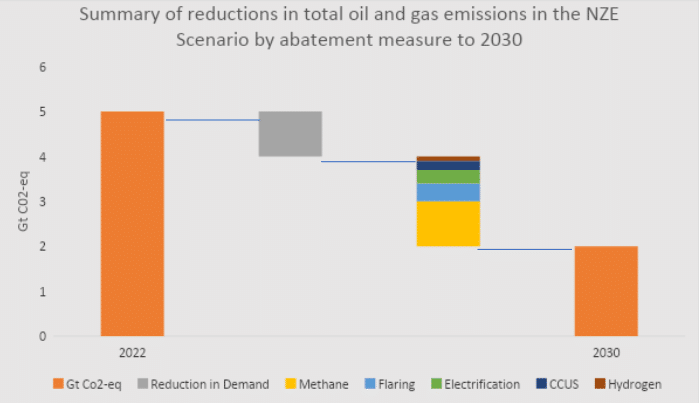LNG’s Carbon Quandary is a Call for Reassessment in the Energy Transition [Op-Ed]
Photo: Shutterstock / Volker Rauch
06 February 2024 – by Kurt Metzger
There was a significant step forward at COP28, where participants agreed to pivotal language to steer away from fossil fuels and achieve net zero by 2050. But the communique also features a step backwards in acknowledging a role for transitional fuels in facilitating the energy transition and ensuring energy security.
The term “transitional fuels” in the COP28 text refers to fossil, natural, and liquefied natural gas (LNG). This inclusion marks a significant victory for the gas industry, especially proponents of LNG. However, current science does not support the expansion of LNG production and associated infrastructure as a pathway to reduce greenhouse gas (GHG) emissions in this critical decade.
The International Energy Agency (IEA) released a special report on oil and gas emissions at COP 28. The report emphasises that total emissions from the gas industry must be reduced by 65% and emission intensity by 55% by 2030. IEA estimates that 30% of the emission reduction will need to come from reduced demand/production, with much of the balance from investment in technology to reduce methane leakage and flaring. This scenario contrasts with industry growth projections.

Shell’s figures released in 2023 show a projected increase in LNG supply from the current 400 million metric tons per annum (MTPA) to 520 MTPA by 2030. Shell’s data on LNG supply under construction predicts that 50% of the increased capacity will come from the USA and Canada, with most new investments originating in the USA. Qatar is expected to contribute the remaining balance through the North Field East Expansion.
The USA only began exporting LNG in 2016, and the carbon footprint of export facilities is now under scrutiny. The US Environmental Protection Agency (EPA) data reveals that carbon dioxide (C02) emissions from all seven operating US LNG export facilities reached 17.6 million tons in 2022, marking an 81% increase since 2019 when there were only six facilities.
CO2 Pollution Surges at US Export LNG Terminals
| LNG Export Facility | CO2 2022 | CO2 2021 | CO2 2020 | CO2 2019 |
| Sabine Pass | 6.90 | 6.20 | 4.60 | 5.60 |
| Elba Island | 0.20 | 0.10 | 0.10 | 0.04 |
| Corpus Christi Liquefaction | 3.40 | 3.30 | 2.00 | 1.70 |
| Cameron LNG | 3.10 | 3.20 | 3.40 | 1.00 |
| Freeport LNG | 0.10 | 0.02 | 0.10 | 0.10 |
| Cove Point | 1.30 | 1.20 | 1.20 | 1.30 |
| Calcasieu Pass (new facility) | 2.60 | 0.00 | 0.00 | 0.00 |
| Total (tons per year) | 17.60 | 14.02 | 11.40 | 9.74 |
According to Reuters, projections from companies suggest that as five US projects currently under construction come online by 2028, they will contribute an additional 27 million tons of CO2 emissions annually. This projection translates to a cumulative total exceeding 45 million tons per year by the decade’s end. These estimates are based on data provided to both the EPA and the Federal Energy Regulatory Commission (FERC).
Beyond CO2 emissions, new research into the life cycle emissions for LNG, including from the Rocky Mountain Institute (RMI) and Cornell University, suggests that methane leakage can eliminate any carbon advantage LNG may have over coal. RMI’s study last July concluded that methane leakage rates as low as 0.2% would result in lifecycle greenhouse gas emissions from natural gas at a similar amount to those emitted by coal-fired energy.
In November 2023, Robert Howarth from Cornell University highlighted that LNG exported from the USA to Asia or Europe may have higher carbon intensity than local coal use due to methane leakage throughout the LNG supply chain, particularly during shipping. Howarth noted, “While some proponents of LNG have argued it has a climate benefit by replacing coal, the analysis presented here disproves this. Across all scenarios considered, total greenhouse gas emissions from LNG are larger than those from coal, ranging from 24% to 274% greater”. The research estimates the final-combustion emissions at the power plant using the LNG as fuel only comprise 23% to 37% of total greenhouse gas emissions when calculated based on life cycle emissions.
The US Department of Energy (DOE) will soon need to decide whether to grant a license to Venture Global’s Calcasieu Pass 2 (CP2) LNG project in Louisiana. This USD 13 billion project, with the potential to export a quarter of the current global LNG supply, is part of the most substantial buildout of LNG infrastructure globally. If the project goes ahead, it will have a significant impact on the USA’s ability to meet its Paris Agreement obligations.
As governments navigate the challenges posed by the LNG industry’s expansion, it is critical to reevaluate their approach. Asia Research & Engagement (ARE)’s latest LNG report recommends a thorough review of energy policies, enhanced emissions monitoring, and increased investments in renewables. Additionally, a reassessment of financial institutions’ lending policies is essential to align with global net-zero objectives. The time has come for a recalibration of our energy strategies to ensure a sustainable and responsible transition to a low-carbon future.
Kurt Metzger has a career spanning three decades in the renewables sector, including managing diverse projects in the US (hydro, RNG, biomass, geothermal, wind) to spearheading sustainable development initiatives in Singapore for the past 26 years.
Disclaimer: The views and opinions expressed in this article are those of the author and do not necessarily reflect the official policy or position of Energy Tracker Asia.


